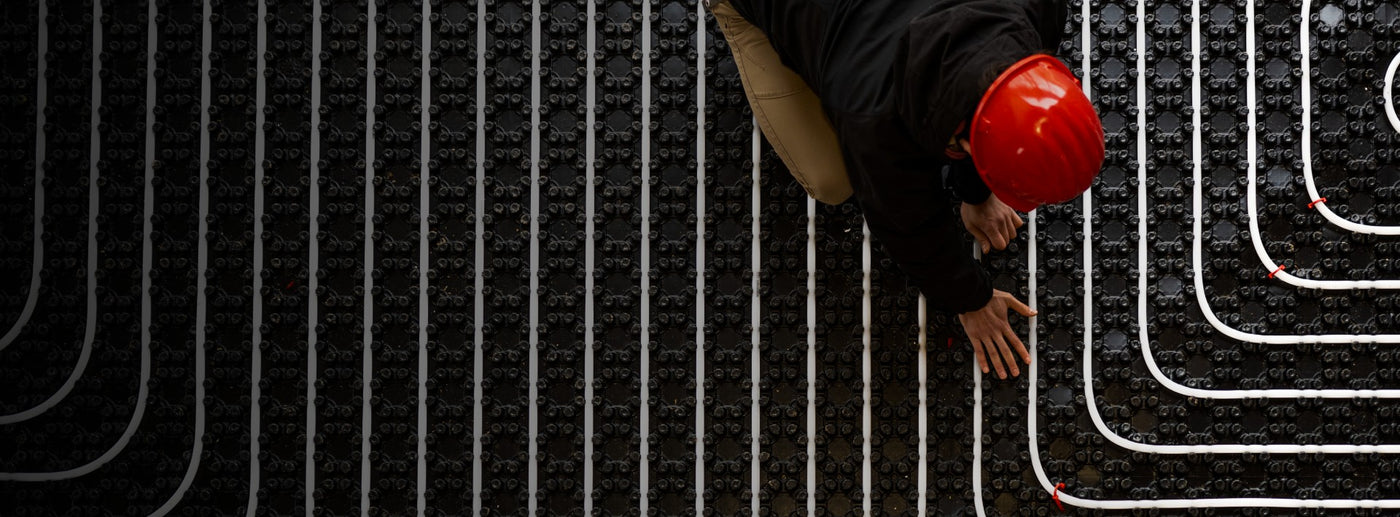Underfloor Heating FAQs
How does underfloor heating work?
How does underfloor heating work?
Water-based underfloor heating, or hydronic heating, works by circulating heated water through pipes or tubing installed under the floor. Here’s a quick overview:
How It Works
Components:
- Pipes/Tubing: Carry heated water, usually made of plastic (PEX) or composite materials.
- Manifold: Distributes water to the pipes and regulates flow and temperature.
- Heat Source: Typically a boiler or heat pump heats the water.
- Thermostat: Controls the floor temperature by adjusting water flow.
Operation:
- Heated water flows through the pipes under the floor, radiating heat upward and warming the room evenly.
- The thermostat maintains the desired temperature by regulating water flow.
Benefits
- Even Heating: Provides consistent warmth with no cold spots.
- Energy Efficiency: Operates efficiently at lower temperatures than traditional radiators.
- Design Freedom: No visible radiators, allowing for flexible room design.
Is underfloor heating more efficient than radiators?
Is underfloor heating more efficient than radiators?
Underfloor heating is generally more efficient than radiators for these reasons:
- Lower Operating Temperature: Works at 30-40°C vs. radiators' 60-75°C, reducing energy use.
- Even Heat Distribution: Provides consistent warmth across the floor, reducing cold spots.
- Improved Heat Retention: Keeps warmth longer even after the system is off.
- Reduced Energy Use: More efficient with low-temperature systems like heat pumps.
- Aesthetic Benefits: Frees up wall space for flexible room design.
While installation costs are higher, the energy savings and comfort benefits often outweigh the initial expense.
What is the lifespan of underfloor heating?
What is the lifespan of underfloor heating?
The lifespan of underfloor heating systems varies depending on the type of system installed and how well it is maintained. Unitherm Underfloor Heating can last up to 50 years with regular maintenance.
Benefits of underfloor heating
Benefits of underfloor heating
Underfloor heating offers several key benefits:
- Even Heat Distribution:
Provides consistent warmth across the entire floor, reducing cold spots. - Energy Efficiency:
Operates at lower temperatures than radiators, which can reduce energy consumption, especially when used with heat pumps. - Comfort:
Warm floors provide a comfortable, cosy environment and can improve overall comfort in the home. - Aesthetic Freedom:
Eliminates the need for visible radiators, allowing for more flexible room design and furniture placement. - Improved Heat Retention:
The thermal mass of the floor helps retain heat longer, even after the system is turned off. - Reduced Dust and Allergens:
By reducing the need for air circulation, underfloor heating can help minimize the movement of dust and allergens. - Increased Property Value:
Modern, efficient heating systems can be an attractive feature for potential buyers.
Is underfloor heating expensive to run?
Is underfloor heating expensive to run?
Underfloor heating is generally cost-effective to run because:
- Energy Efficiency: Operates at lower temperatures (30-40°C) than radiators, reducing energy use.
- Heat Source: More economical with heat pumps; running costs can be higher with traditional boilers.
- Insulation: Works best in well-insulated homes, minimising heat loss.
- Controls: Smart thermostats help optimise energy use.
Overall, while installation costs can be higher, running costs are usually lower compared to traditional heating systems.
What is the best way to control an underfloor heating system?
What is the best way to control an underfloor heating system?
The best way to control underfloor heating is with:
- Programmable Thermostats: Set heating schedules to manage energy use.
- Smart Thermostats: Offer remote control, learning capabilities, and automatic adjustments.
- Zoning Systems: Heat different areas independently for tailored comfort.
- Floor Sensors: Monitor and adjust floor temperature to prevent overheating.
- Room Sensors: Measure air temperature for even heating.
- Home Automation Integration: Connect with smart home systems for seamless control.
These controls optimise comfort and energy efficiency.
Can underfloor heating be installed in existing buildings?
Can underfloor heating be installed in existing buildings?
Yes, underfloor heating can be installed in existing buildings. Here’s how:
Options for Installation
- Wet System (Hydronic):
Installation: Typically requires lifting the floor to lay pipes and install a screed. It can be more challenging in existing buildings with finished floors.
Best For: Major renovations or when replacing existing flooring.
Considerations
- Floor Height: Ensure there’s enough space to accommodate the system without significantly raising the floor height.
- Flooring Type: Compatibility with existing flooring is crucial. Some types, like tiles, work well with underfloor heating.
- Insulation: Proper insulation is needed to ensure efficiency and reduce heat loss.
How long does it take to warm up underfloor heating?
How long does it take to warm up underfloor heating?
Water-based underfloor heating typically takes 2 to 6 hours to warm up, depending on several factors:
Factors Affecting Warm-Up Time
- System Size: Larger systems may take longer to reach the desired temperature.
- Floor Type: Materials like concrete or tiles may take longer to heat up compared to other types of flooring.
- Insulation: Better insulation helps reduce heat loss and can speed up the process.
- Flow Rate: The rate at which hot water circulates through the pipes can impact how quickly the system warms up.
Considerations
- Pre-Heating: It’s best to start heating in advance to ensure the space is warm when needed, as water-based systems take longer to reach the optimal temperature compared to other heating methods.
-
Technical Support
Need help or advice?
We'd be happy to help




